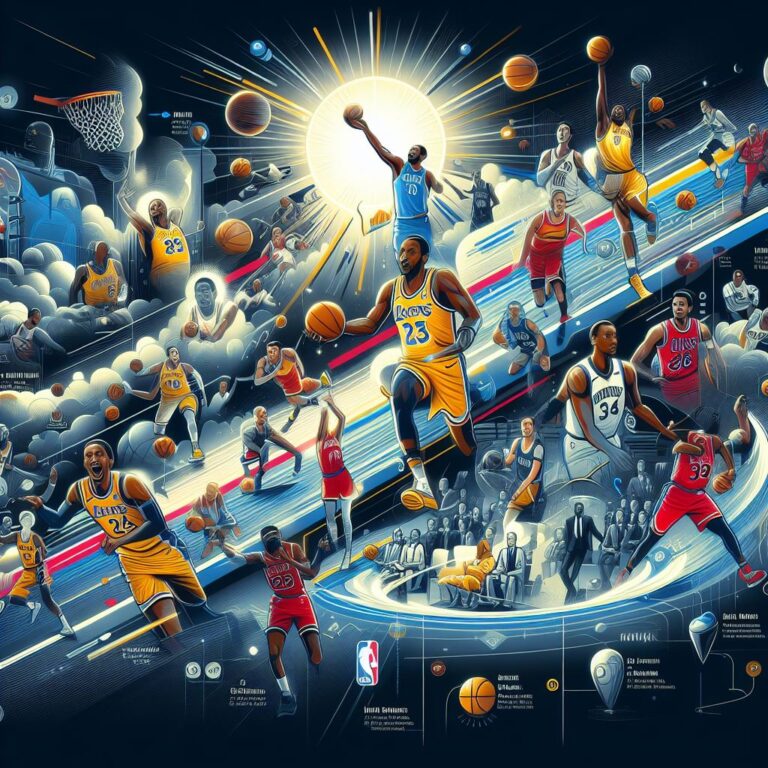The National Basketball Association (NBA) is more than just a league; it’s a cultural phenomenon, a melting pot of athleticism, entertainment, and global influence. Its journey, spanning over seven decades, is a captivating tale of innovation, rivalries, and iconic moments that have captivated generations. So, lace up your virtual sneakers and join us as we embark on a deep dive into the history of the NBA, a courtside seat to witness the evolution of a game that transcended its boundaries.
From Humble Beginnings to Hardwood Glory:
The NBA’s story starts in 1946, when the Basketball Association of America (BAA) emerged, challenging the dominance of the National Basketball League (NBL). This era was marked by regional rivalries and legendary players like George Mikan, whose sheer size and skill revolutionized the game. However, financial struggles and a desire for expansion led to a historic merger in 1949, giving birth to the NBA as we know it.
The Golden Age: A Tapestry Beyond Wins and Losses:
While the Celtics-Lakers rivalry dominated the headlines, the 1950s and 60s were also a period of social and cultural significance. Bill Russell, facing racial prejudice on and off the court, became a symbol of the Civil Rights Movement, using his platform to advocate for equality. Meanwhile, Wilt Chamberlain, shattering scoring records with his sheer size and athleticism, challenged notions of what was possible in the game. This era wasn’t just about basketball; it was a microcosm of America, reflecting its changing social landscape and inspiring conversations that transcended the hardwood.
The ABA-NBA Merger: A Shot of Innovation:
The 1970s witnessed the thrilling clash of two leagues: the established NBA and the upstart American Basketball Association (ABA). The ABA, with its innovative three-point line, red, white, and blue ball, and slam dunk contests, injected a dose of excitement and experimentation into the game. The 1976 merger brought these two distinct styles together, enriching the NBA with iconic players like Julius “Dr. J” Erving and the Denver Nuggets’ high-flying game. This period also saw the rise of the “Pistons Bad Boys,” a team that redefined physicality and challenged the established order, pushing the boundaries of what was considered acceptable on the court. Their gritty, defensive style forced a reevaluation of basketball strategies and added a new layer of intrigue to the league.
The Showtime Lakers and the Bird-Magic Rivalry: A Dance of Opposites:
The 1980s were painted in the vibrant colors of “Showtime,” a philosophy embodied by the Los Angeles Lakers under the charismatic leadership of Magic Johnson. Their fast-paced, flashy style, featuring no-look passes and alley-oop dunks, was a visual spectacle that captivated audiences worldwide. But their reign wasn’t met without resistance. Across the country, the Boston Celtics, led by the cerebral Larry Bird, presented a stark contrast. Their methodical, team-oriented approach, anchored by Bird’s pinpoint shooting and court vision, challenged the Lakers’ flamboyant style. This epic rivalry, dubbed the “Bird-Magic Rivalry,” wasn’t just about contrasting styles; it was a clash of personalities, a battle for basketball supremacy that transcended individual accolades. This era also marked the arrival of Michael Jordan, a rookie with immense potential who was just beginning to cast a long shadow over the league.
The Air Jordan Era: Beyond the Court, a Cultural Phenomenon:
The 1990s belonged to Michael Jordan, a player who transcended the sport and became a cultural icon. His gravity-defying dunks, unmatched competitive spirit, and six NBA championships with the Chicago Bulls cemented his legend. He wasn’t just a basketball player; he was a global brand, his influence extending far beyond the court. His iconic Air Jordan shoes and apparel lines became cultural touchstones, worn by athletes and celebrities alike. Jordan’s impact went beyond fashion; he inspired a generation of young players, particularly from marginalized communities, to dream big and chase their aspirations. He became a symbol of hope and perseverance, proving that anything was possible with hard work and dedication.
The Modern Era: A League Transformed, Challenges Arise:
The 21st century ushered in a new era for the NBA, one characterized by globalization, technological advancements, and changing fan expectations. The league expanded its reach to new markets, attracting international talent and fostering a global fan base. Yao Ming of China and Dirk Nowitzki of Germany became global superstars, showcasing the league’s growing international appeal. The rise of social media and streaming services revolutionized fan engagement, offering unprecedented access to players and teams. However, challenges emerged alongside the opportunities. The emergence of “superteams,” with teams like the Miami Heat and the Golden State Warriors dominating the landscape, raised concerns about competitive balance. Issues like player empowerment and the use of analytics in decision-making sparked heated debates. Despite these challenges, the NBA remains a dynamic and evolving entity, constantly adapting to the changing landscape and finding new ways to engage its passionate fanbase.
Looking Ahead: A New Chapter Unfolds, The Legacy Lives On:
As the NBA enters its eighth decade, it faces new challenges and opportunities. The continued rise of technology, the evolving media landscape, and the ever-changing social climate will undoubtedly shape the league’s future. However, one thing remains constant: the enduring power of the game to captivate audiences with its athleticism, drama, and storytelling. From the humble beginnings of the BAA to the global phenomenon it is today, the NBA’s history is a testament to the enduring power of the game and its ability to unite people across cultures and generations.
Check out more articles like this at Sports Archives – Topic In One Article
